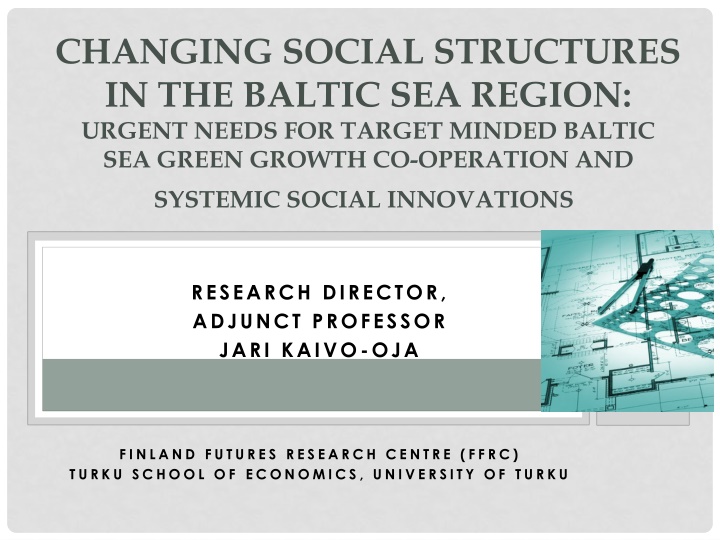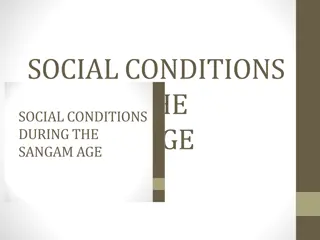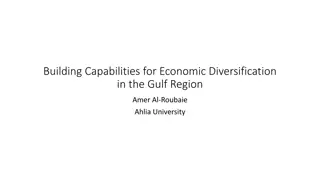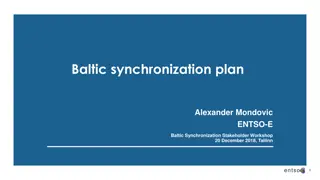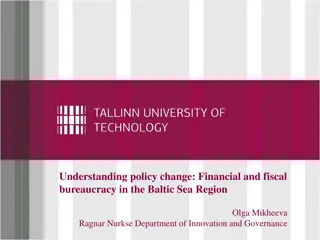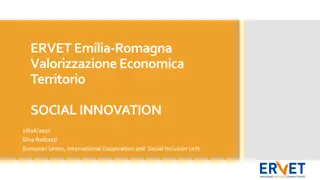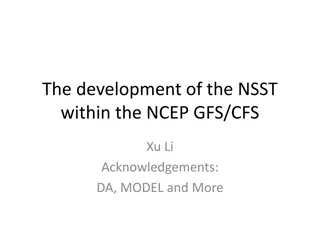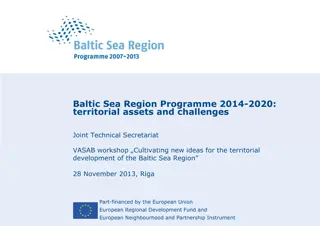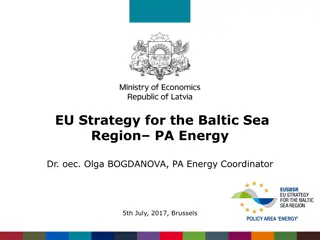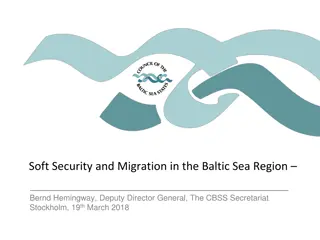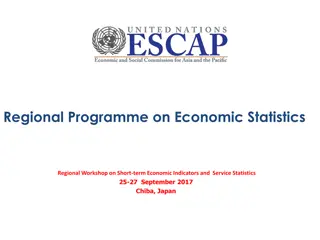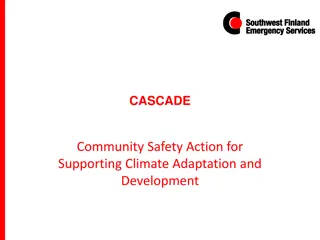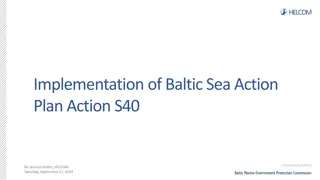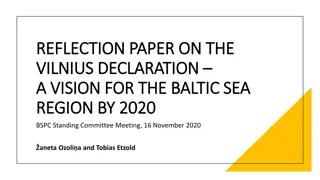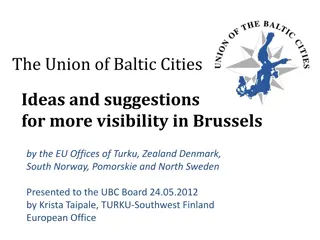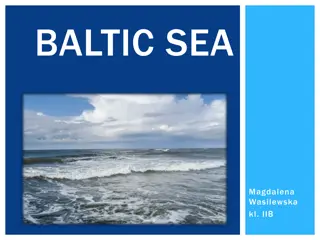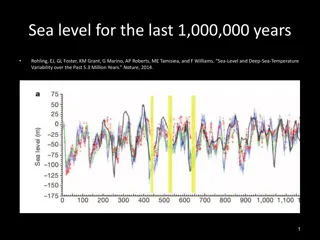Transforming Social and Economic Structures in the Baltic Sea Region
Urgent cooperation is needed for Baltic Sea green growth initiatives and innovative research to address changing social and economic structures. Key themes include green growth, global climate change, economic growth, and innovation platforms. The shift towards the sixth wave and green growth presents challenges and opportunities in areas such as resource-efficient technologies, bioeconomy, and societal transformation through systemic innovations.
Download Presentation

Please find below an Image/Link to download the presentation.
The content on the website is provided AS IS for your information and personal use only. It may not be sold, licensed, or shared on other websites without obtaining consent from the author.If you encounter any issues during the download, it is possible that the publisher has removed the file from their server.
You are allowed to download the files provided on this website for personal or commercial use, subject to the condition that they are used lawfully. All files are the property of their respective owners.
The content on the website is provided AS IS for your information and personal use only. It may not be sold, licensed, or shared on other websites without obtaining consent from the author.
E N D
Presentation Transcript
CHANGING SOCIAL STRUCTURES IN THE BALTIC SEA REGION: URGENT NEEDS FOR TARGET MINDED BALTIC SEA GREEN GROWTH CO-OPERATION AND SYSTEMIC SOCIAL INNOVATIONS RESEARCH DIRECTOR, ADJUNCT PROFESSOR JARI KAIVO-OJA F I N L A N D F U T U R E S R E S E A R C H C E N T R E ( F F R C ) T U R K U S C H O O L O F E C O N O M I C S , U N I V E R S I T Y O F T U R K U
CHANGING ECONOMIC STRUCTURES: KEY THEMES Green growth paradigm, global climate change, CO2 emissions Economic growth, employment, investments Household incomes, welfare, Income distribution Various trend analyses
FROM TRIPLE HELIX TO QUARTET HELIX (KAIVO-OJA 2011) The Academia The Industries The Government Consumers and end-users
SIXTH WAVE AND GREEN GROWTH AS AN EUROPEAN CHALLENGE The expansion of resource efficient technologies Globalization: decentralization of global powers The rise of bioeconomy Key megatrends Key innovation platforms Key Driverds for the 6th Wave Demographic change Implying ageing and longevity Digitalization and dominance of second economy Growth of health services Key trajectories for social change Maturing environmental concerns Rise of complex docieties Web-based empowerment of people
3-LEVEL MODEL OF SYSTEMIC INNOVATION Landscape Sixth Wave: Megatrends and macrotrends Socio-technical regimes Socio- technical regime A Socio- technical regime B Socio- technical regime C Socio- technical regime D Socio- technical regime E Niche level: New ideas and inventions Niche B Niche D Niche C
FROM INTERNET TO ROBOTICS: A FUTURE SOURCE FOR PRODUCTIVITY AND SMARTNESS Source: ASIMO 2012 See more European Robotics Week 2013: http://www.eurobotics-project.eu/eurobotics
SYSTEMIC INNOVATION PERSPECTIVE: KILLER INNOVATION MODEL (KAIVO-OJA 2011) Systemic TBI innovation Business- innovation Technological innovation Social innovation
EXAMPLE OF SYSTEMIC INNOVATION THINKING (KOREAN UBIQUITOUS CITY ASSOCIATION 2006)
GREEN GROWTH STRATEGY AS INNOVATION CHALLENGE (GREEN GROWTH KNOWLEDGE PLATFORM 2013) Green growth requires that public agencies are (1) able to price externalities and value environmental assets, (2) stakeholders are able to find innovations (technological, business and social innovations) to break unsustainable development paths, (3) the creation and dissemination of new environmentally sustainable technologies, goods and services, (4) sectoral shifts and changes in comparative advantage that inevitably imply winners and losers.
GREEN GROWTH AND NEEDS OF SOCIO-CULTURAL CHANGES (SOURCE: GREEEN GROWTH KNOWLEDGE PLATFORM 2013) Future comprehensive wealth Saving/investment Outputs (material and non-material savings) Policies Production Consumption Economic opportunities Inputs Drawing inputs from wealth Current comprehensive wealth
STAGES OF PUBLIC POLICY FOR THE BALTIC SEA POLITICS Typical stages of public policy are: (1) Agenda setting, (2) policy formulation, (3) decision-making, (4) policy implementation and (5) monitoring and evaluation.
GDP GROWTH (%) IN THE BALTIC SEA COUNTRIES, YEARS 1961-2012 GDP (in dollars) in the Baltic Sea countries, 1961-2012 (World Bank 2013) 15 10 5 Belarus Denmark 0 Estonia Finland -5 Germany GDP (%) -10 Latvia Norway -15 Lithuania Poland -20 Russia Sweden -25 -30 -35
BALTIC SEA REGION (AVERAGE GROWTH RATE OF 11 BS COUNTRIES, %) Baltic Sea Countries (average GDP growth of the BS countries, %) 8 6 4 2 GDP growth, % 0 -2 -4 -6 -8
AVERAGE ECONOMIC GROWTH, BALTIC SEA COUNTRIES (AVERAGE GDP GROWTH OF THE BS COUNTRIES, %) Baltic Sea countries (average GDP growth of the BS countries, %) 8 y = 0.0036x2 - 0.2441x + 6.1527 R = 0.1395 6 4 y = -0.0439x + 4.2197 R = 0.0623 2 GDP growth, % 0 -2 -4 -6 -8
EMPLOYMENT RATES OF NATIVE- AND FOREIGN- BORN POPULATION BY EDUCATIONAL ATTAINMENT IN SOME BALTIC SEA COUNTRIES, YEAR 2007 (OECD 2012) Difference between native-born and foreign- born 2007 Native-born Foreign-born 2007 Low High Total Low High Total Denmark 51,98113 82,02673 63,88262 50,87713 73,44987 57,68003 6,2 Estonia 29,51551 82,47014 59,66663 20,08191 69,1683 48,30696 11,4 Finland 29,11994 76,27982 56,96619 39,21423 71,58916 59,89582 -2,9 Germany 29,76301 74,06977 55,8576 - Norway 51,39146 86,32908 71,08491 52,2312 82,43884 68,05048 3,0 Poland 17,9292 76,31345 48,92329 4,222524 44,9374 14,06986 34,9 Sweden 44,76384 82,49948 68,42363 40,84492 73,36278 57,62029 10,8 Russian Federation 30,1 79,1 57,9 32,4 76,4 60,7 -2,8
EMPLOYMENT RATES OF NATIVE- AND FOREIGN- BORN POPULATION BY EDUCATIONAL ATTAINMENT IN SOME BALTIC SEA COUNTRIES, YEAR 2011 (OECD 2012) Difference between native-born and foreign- born 2011 Native-born Foreign-born 2011 Low High Total Low High Total Denmark 58,86311 86,57713 74,71888 48,41797 75,98556 61,6778 13,04 Estonia 30,99904 80,78799 65,32655 29,30565 69,61436 63,89933 1,43 Finland 40,99464 84,81853 69,40752 44,85007 69,20665 61,12176 8,28 Germany 43,21679 89,26231 73,75694 53,40668 77,31918 66,49925 7,26 Norway 58,20015 90,55224 75,97524 55,67231 82,04932 70,20329 5,77 Poland 23,48173 82,43909 59,66775 15,22522 72,22753 55,33718 4,33 Sweden 48,67034 89,71784 76,58259 43,94978 75,16999 62,57937 14,00 Russian Federation
REAL HOUSEHOLD DISPOSABLE INCOME: CHANGES IN SOME BALTIC SEA COUNTRIES (OECD 2012) Sweden Poland Norway Average annual growth in percentage: 3-year average at end of period (2009- 11) Average annual growth in percentage: 3-year average at beginning of period (1999-2001) Germany Finland Estonia Denmark -4.00 -3.00 -2.00 -1.00 0.00 1.00 2.00 3.00 4.00 5.00 6.00
INVESTMENTS (GROSS FIXED CAPITAL FORMATION, % CHANGES) IN SOME BALTIC SEA COUNTRIES, IN THE EU-27, EA17, RUSSIA: CHANGES IN 1999-2001, 2008-2010 (OECD 2012) EU27 EA17 Russian Federation Sweden Poland High Low Norway Germany Finland Estonia Denmark -20.0 0.0 20.0 40.0 60.0 80.0 100.0
ACTIVE POPULATION IN THE BALTIC SEA COUNTRIES (%, 15-64 YEARS OLD) Active population in the Baltic Sea countries (%,15-64 years old) 74 72 70 Belarus Population 15-64 years old, %) 68 Denmark Estonia 66 Finland Germany 64 Latvia 62 Norway Lithuania 60 Poland Russia 58 Sweden 56 54
ACTIVE POPULATION IN THE BALTIC SEA REGION, YEARS 1960-2012 Average size population of 15-64 years old, % in the Baltic Sea Countries (11 countries) 69 68 67 66 65 64 63 62 196019621964196619681970197219741976197819801982198419861988199019921994199619982000200220042006200820102012
YOUTH POPULATION UNDER THE AGE OF 15 IN SOME BALTIC SEA COUNTRIES AND IN THE EU-27, 2000-2050 (OECD 2012) Youth population under the age of 15 in some Baltic Sea countries and in the EU-27, 2000-2050 25.0 20.0 Estonia Finland 15.0 Denmark Germany % Norway 10.0 Poland Sweden EU 27 5.0 0.0 2000 2010 2020 2030 2040 2050
ELDERLY POPULATION (65 OR OVER 65 YEARS) IN SOME BALTIC SEA COUNTRIES AND IN THE EU-27, 2000-2050 (OECD 2012) Elderly population (65 orover 65 years old) in some Baltic Sea countries and in the EU-27, 2000-2050 35.0 30.0 25.0 Estonia Finland 20.0 Denmark Germany % Norway 15.0 Poland Sweden 10.0 EU 27 5.0 0.0 2000 2010 2020 2030 2040 2050
POPULATION LESS THAN 15 YEARS OLD AND 65 OR OVER 65 YEARS OLD IN THE BALTIC SEA COUNTRIES (OECD 2012) Population less than 15 years old and 65 or over 65 years old in the Baltic Sea countries 50.0 45.0 40.0 35.0 Estonia 30.0 Finland Denmark 25.0 % Germany Norway 20.0 Poland 15.0 Sweden EU 27 10.0 5.0 0.0 1990 2000 2010 2020 2030 2040 2050 2060 Time
VALUE ADDED OF INDUSTRY IN THE BALTIC SEA COUNTRIES (%, VALUE ADDED OF GDP), YEARS 1966-2010 Industry in the Baltic Sea countries (%, value added of GDP), years 1966-2010 60 50 Belarus %, value added of GDP Denmark 40 Estonia Finland 30 Germany Latvia Norway 20 Lithuania Poland 10 Russia 0
AVERAGE, VALUE ADDED (% OF GDP) IN BALTIC COUNTRIES, YEARS 1996-2010 Average, BS-countries, industry, value added (% of GDP) 45 40 35 %, industry, value added of GDP 30 y = -0.0083x2 + 0.3708x + 31.79 R = 0.6082 25 20 15 10 5 0 19601962196419661968197019721974197619781980198219841986198819901992199419961998200020022004200620082010
HIGH-TECH EXPORTS IN SOME BALTIC SEA COUNTRIES, YEARS 2007-2012 (EUROSTAT 2013) High-tech exports in some Baltic Sea countries, years 2007-2012 20 18 16 EU (28 countries) 14 EU (27 countries) Denmark 12 % of exports Germany Estonia 10 Latvia 8 Lithuania Poland 6 Finland Sweden 4 2 0 2007 2008 2009 2010 2011 2012
EMPLOYMENT IN HIGH- AND MEDIUM-HIGH- TECHNOLOGY MANUFACTURING SECTORS, SHARE OF TOTAL EMPLOYMENT (%) (EUROSTAT 2013) Employment in high- and medium-high-technology manufacturing sectors, Share of total employment (%) 12 10 EU (27 countries) Share of total employment Denmark 8 Germany Estonia Latvia 6 Lithuania Poland Finland 4 Sweden Norway 2 0 1997 1998 1999 2000 2001 2002 2003 2004 2005 2006 2007 2008
EMPLOYMENT IN KNOWLEDGE-INTENSIVE SERVICE SECTORS, SHARE OF TOTAL EMPLOYMENT IN SOME BALTIC SEA COUNTRIES, YEARS 1997-2008(EUROSTAT 2013) Employment in knowledge-intensive service sectors, share of total employment in some Baltic Sea countries, years 1997-2008 60 50 EU (27 countries) Share of total employment, % Denmark 40 Germany Estonia Latvia 30 Lithuania Poland 20 Finland Sweden Norway 10 0 1997 1998 1999 2000 2001 2002 2003 2004 2005 2006 2007 2008
RESEARCH AND DEVELOPMENT EXPENDITURE, BY SECTORS OF PERFORMANCE, % OF GDP (EUROSTAT 2013) Research and development expenditure, by sectors of performance, % of GDP 1 EU (28 countries) 0,9 EU (27 countries) 0,8 Euro area (17 countries) Denmark 0,7 Germany 0,6 Akselin otsikko Estonia 0,5 Latvia 0,4 Lithuania Poland 0,3 Finland 0,2 Sweden 0,1 Norway 0 2000 2001 2002 2003 2004 2005 2006 2007 2008 2009 2010 2011
CO2 EMISSIONS IN GERMANY, IN POLAND AND IN THE RUSSIAN FED., YEARS 1992-2009 CO2 emissions in Germany, Poland and Russian Fed., years 1992-2009 2500000 2000000 1500000 Axis Title Germany Poland Russia 1000000 500000 0 1992 1993 1994 1995 1996 1997 1998 1999 2000 2001 2002 2003 2004 2005 2006 2007 2008 2009
CO2 EMISSIONS (TONS) IN BALTIC SEA COUNTRIES, YEARS 1992-2009 CO2 emissions (tons) in Baltic Sea countries, 1992-2009 100000 90000 80000 70000 Belarus CO2 emissions (tn) Denmark 60000 Estonia Finland 50000 Latvia 40000 Norway Lithuania 30000 Sweden 20000 10000 0 1992 1993 1994 1995 1996 1997 1998 1999 2000 2001 2002 2003 2004 2005 2006 2007 2008 2009
GROSS DOMESTIC EXPENDITURE ON R&D IN SOME BALTIC SEA COUNTRIES, YEARS 1981- 2010 Gross Domestic Expenditure on R&D - GERD (million current PPP $) in some Baltic Sea Countries, years 1981- 2010 (Source: OECD 2013) 100000 90000 80000 70000 Million current PPP $) Denmark 60000 Estonia Finland 50000 Germany 40000 Norway Poland 30000 Sweden 20000 10000 0 1981 1982 1983 1984 1985 1986 1987 1988 1989 1990 1991 1992 1993 1994 1995 1996 1997 1998 1999 2000 2001 2002 2003 2004 2005 2006 2007 2008 2009 2010
VENTURE CAPITAL INVESTMENTS, % OF GDP IN SOME BALTIC SEA COUNTRIES, YEARS 2007-2012 (EUROSTAT 2013) Venture capital investments, % of GDP in some Baltic Sea countries, years 2007-2012 0.16 0.14 0.12 EU (27 countries) 0.1 Denmark % of GDP Germany 0.08 Poland Finland 0.06 Sweden Norway 0.04 0.02 0 2007 2008 2009 2010 2011 2012
GROSS DOMESTIC EXPENDITURE ON R&D - GERD (MILLION CURRENT PPP $) IN EU-28, EU-15, USA, JAPAN, CHINA, RUSSIA AND SOUTH AFRICA Gross Domestic Expenditure on R&D - GERD (million current PPP $) in EU-28, EU-15, USA, Japan, China, Russia and South Africa 450000 400000 350000 300000 EU-28 Million current PPP $ EU-15 250000 USA Japan 200000 China 150000 Russia South Africa 100000 50000 0 1981 1982 1983 1984 1985 1986 1987 1988 1989 1990 1991 1992 1993 1994 1995 1996 1997 1998 1999 2000 2001 2002 2003 2004 2005 2006 2007 2008 2009 2010 2011
SOME POLICY RECOMMENDATIONS Co-operation in the field of the development of social innovations (education, employment and job creation) is a challenging issue in the Baltic Sea region: more strategic co- operation is needed among BS partners More productive use of innovation and R&D allocations are needed in near future Baltic Sea countries should position themselves more systematically and aggresively in the global trade arena The Baltic Sea countries are key players in the EU s innovation policy arene: they should get more attention inside in the R&D/innovation field the European Union Green Growth challenge is a shared challenge in the Baltic Sea countries: Green Growth Knowledge Platform needs more political attention in the Baltic Sea co-operation
THANK YOU! Research Director, Adjunct Prof. Jari Kaivo-oja Finland Futures Research Centre, Turku School of Economics Email: jari.kaivo-oja@utu.fi Web: http://www.utu.fi/en/units/ffrc/Pages/home.aspx Tel. +358-(2) 333 9832, +358-(41) 753 0244
